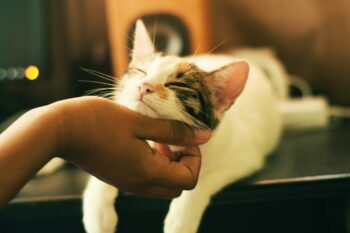No matter what species you are, arthritis pain is no fun. But in cats, arthritis may be especially painful since it often goes undiagnosed.
Because cats hide their pain, they may not appear lame as dogs with arthritis often do. But just because their symptoms may be subtle, that doesn’t mean they don’t need care for this painful condition. Routine check-ups for older cats can help diagnose the problem.
If your cat has been diagnosed with arthritis, she will really appreciate anything you do to make her more comfortable, including a thorough medical exam and consultation with your veterinarian about possible medical treatments, which could include aspirin. (Be absolutely sure to consult carefully with your veterinarian about dosage, because too much aspirin can be toxic to your cat. And remember, any dose of Tylenol is fatal to cats.)
Many pet-owners report success with nutraceuticals such as glucosamine and chondroitin, which may help rebuild damaged cartilage and which are available over-the-counter in many pet supply stores. Drew Weigner, DVM, board-certified feline specialist, points out that there is little hard data on how effective nutraceuticals are in cats; however, they have “been shown to be moderately effective in humans, horses, and dogs [and that] it is a safe product and many clients report some improvement with long-term use,” he says. “It can take up to two months to be effective, so is not used for acute symptoms.”
There are a lot of things you can do at home to make your cat more comfortable, including a nice warm bed to ease her achy bones. There are now many options in heated bedding for pets, from the plug-them-in variety to beds with thermo-reflective materials, which reflect your cat’s own body heat back to her (sounds nice, doesn’t it?). While hot water bottles may be a little awkward, a small microwavable disc works well to warm up your cat’s favorite sleeping spot.
Jumping is bad for arthritis since it puts stress on already damaged joints. Make your cat’s life easier by adding steps or ramps to her favorite resting spots such as the couch or your bed. Carpeted, cat-size steps are available at many pet supply stores. Elevating her water and food bowls so she doesn’t have to crouch down is another nice thing you can do. Also, a litterbox with lower sides will make it easier for a stiff cat to get in and out.
While high-impact exercise is discouraged with arthritis, low-impact exercise can actually help by building muscle mass around the joint to support it. Unfortunately, “The problem is persuading a cat to exercise in this fashion!” says Weigner. If kitty’s up for it, try taking her for a regular, short, slow walks on a leash (but don’t do anything too drastically or irregularly — sore muscles definitely won’t help her pain). If kitty is too heavy, managed weight loss will also help take a load, literally, off those joints — but consult your veterinarian first about a weight loss plan. Gentle massage that doesn’t invade kitty’s boundaries (and some cats can have some pretty fierce boundaries) can also help relieve stiffness and soreness. Let her set the pace.
Remember, if kitty is hurting, extra stress, either emotional or physical, won’t make her feel better. Just think about what best eases your pain — usually, gentleness, warmth and thoughtfulness go a long way, no matter whether you’ve got two legs or four.







